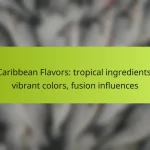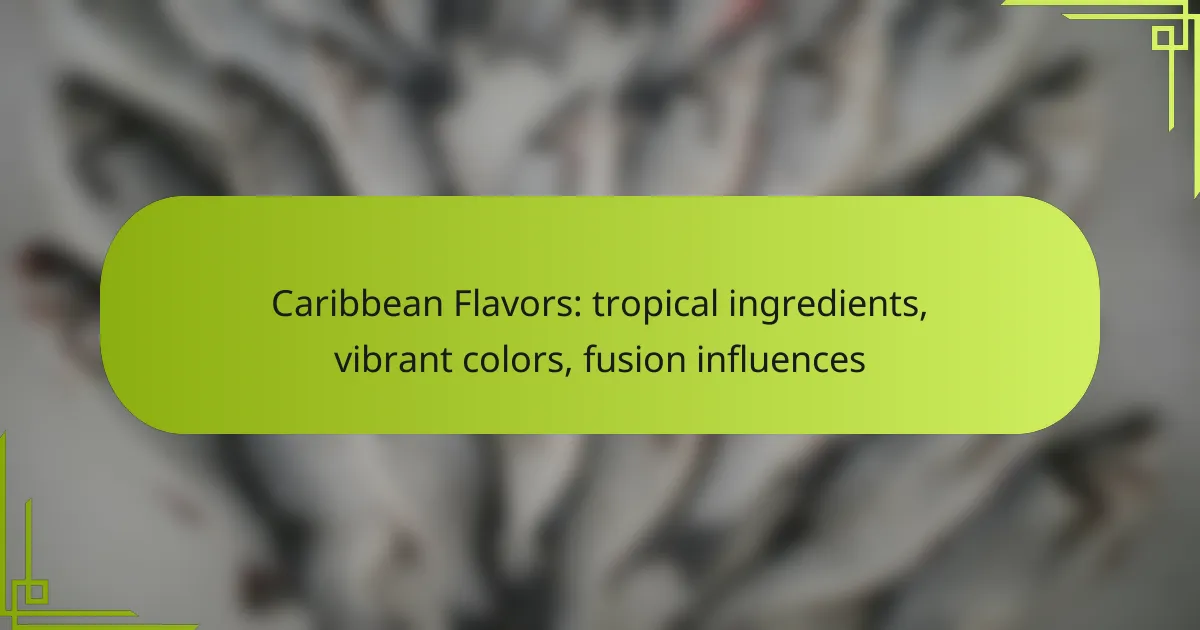Caribbean flavors bring a delightful fusion of tropical ingredients, vibrant colors, and bold spices to the culinary world. By incorporating fresh fruits, aromatic herbs, and unique spices, dishes become not only flavorful but also visually stunning. This rich tapestry of flavors reflects the region’s diverse cultural influences and agricultural heritage, making Caribbean cuisine a dynamic addition to modern cooking.

How to incorporate Caribbean flavors into your cooking?
Incorporating Caribbean flavors into your cooking involves using tropical ingredients, vibrant colors, and fusion influences to create dishes that are both flavorful and visually appealing. Focus on integrating fresh fruits, spices, and herbs that are characteristic of Caribbean cuisine.
Using tropical fruits like mango and pineapple
Tropical fruits such as mango and pineapple are essential for adding sweetness and acidity to Caribbean dishes. These fruits can be used fresh in salads, blended into smoothies, or cooked into salsas to enhance the overall flavor profile.
When selecting mangoes, look for ones that yield slightly to pressure and have a fragrant aroma. Pineapples should feel heavy for their size and have a sweet smell at the base. Both can be enjoyed in a variety of dishes, from grilled meats to desserts.
Integrating spices such as allspice and nutmeg
Allspice and nutmeg are key spices that define Caribbean cuisine, providing warmth and depth to dishes. Allspice, often used in jerk seasoning, has a flavor reminiscent of cinnamon, cloves, and nutmeg combined, making it versatile for both savory and sweet recipes.
Nutmeg adds a distinct aroma and is commonly used in desserts and beverages. Use these spices sparingly, as their strong flavors can easily overpower a dish. A pinch can enhance a marinade or a sauce without overwhelming other ingredients.
Creating vibrant sauces with scotch bonnet peppers
Scotch bonnet peppers are a staple in Caribbean cooking, known for their heat and fruity flavor. These peppers can be used to create vibrant sauces that add a kick to any dish. A simple hot sauce can be made by blending scotch bonnet peppers with vinegar, garlic, and salt.
When working with scotch bonnet peppers, wear gloves to avoid skin irritation, and start with a small amount to gauge the heat level. These sauces can be drizzled over grilled meats, seafood, or even used as a condiment for rice and beans.
Utilizing fresh herbs like cilantro and thyme
Fresh herbs such as cilantro and thyme are crucial for brightening up Caribbean dishes. Cilantro adds a fresh, citrusy flavor that complements many tropical ingredients, while thyme provides an earthy note that enhances savory dishes.
Incorporate these herbs into marinades, dressings, or as garnishes. For optimal flavor, add fresh herbs towards the end of cooking to preserve their vibrant taste. Avoid overcooking them, as this can lead to a loss of their aromatic qualities.

What are the key tropical ingredients in Caribbean cuisine?
Key tropical ingredients in Caribbean cuisine include fruits, vegetables, and spices that are vibrant and flavorful. These ingredients not only enhance the taste but also reflect the region’s rich cultural influences and agricultural bounty.
Mango as a staple fruit
Mango is a quintessential fruit in Caribbean cuisine, celebrated for its sweet and juicy flavor. It is often used in salads, salsas, and desserts, adding a tropical touch to various dishes.
When selecting mangoes, look for those that yield slightly to pressure and have a fragrant aroma. They can be enjoyed fresh, dried, or blended into smoothies, making them versatile for any meal.
Plantains for savory dishes
Plantains are a staple in many Caribbean savory dishes, known for their starchy texture and ability to absorb flavors. They can be fried, boiled, or baked, and are commonly served as a side dish or main ingredient.
Green plantains are typically used for frying to create tostones, while ripe plantains are sweeter and can be used in dishes like mofongo. When cooking, ensure they are peeled and sliced evenly for consistent cooking.
Coconut for desserts and curries
Coconut is a versatile ingredient in Caribbean cooking, used in both desserts and savory curries. Its rich flavor and creamy texture enhance dishes like coconut rice, curries, and puddings.
Fresh coconut can be grated for use in baking or extracted for milk, which is a key component in many traditional recipes. When using coconut milk, choose unsweetened varieties for savory dishes to maintain balance in flavor.
Callaloo as a leafy green
Callaloo is a popular leafy green in Caribbean cuisine, often compared to spinach. It is rich in nutrients and can be sautéed, steamed, or used in soups and stews.
This green can be combined with ingredients like onions, garlic, and peppers to create a flavorful side dish. When preparing callaloo, wash the leaves thoroughly to remove any grit and ensure a clean taste.

How do Caribbean flavors influence modern fusion cuisine?
Caribbean flavors significantly shape modern fusion cuisine by introducing vibrant ingredients and bold spices, creating unique culinary experiences. The blend of tropical fruits, fresh seafood, and aromatic herbs enhances dishes, making them more dynamic and appealing to diverse palates.
Caribbean-Japanese sushi variations
Caribbean-Japanese sushi variations incorporate tropical ingredients like mango, avocado, and jerk seasoning into traditional sushi rolls. For example, a sushi roll might feature grilled shrimp marinated in a spicy mango sauce, offering a sweet and savory contrast to the usual sushi flavors.
When experimenting with these variations, consider using local fish such as snapper or mahi-mahi, which can be paired with wasabi-infused coconut cream for an added twist. This fusion not only highlights Caribbean ingredients but also respects the artistry of sushi-making.
Latin-Caribbean taco fusions
Latin-Caribbean taco fusions blend elements from both cuisines, using soft corn tortillas filled with Caribbean-inspired ingredients. Popular fillings include pulled pork seasoned with adobo and topped with pineapple salsa, creating a refreshing and flavorful bite.
To enhance these tacos, consider adding a drizzle of lime crema or a sprinkle of fresh cilantro. This combination not only elevates the dish but also showcases the vibrant colors and flavors typical of Caribbean cuisine.
Caribbean-inspired barbecue techniques
Caribbean-inspired barbecue techniques focus on marinating meats in bold spices and tropical fruits, such as guava or papaya, to create rich flavors. Techniques like jerk seasoning, which includes allspice and Scotch bonnet peppers, are essential for achieving that authentic Caribbean taste.
When barbecuing, aim for low and slow cooking methods to allow the flavors to penetrate the meat thoroughly. Pairing grilled meats with sides like coconut rice or plantains can further enhance the meal, making it a true fusion of Caribbean and barbecue traditions.

What are the vibrant colors associated with Caribbean dishes?
The vibrant colors of Caribbean dishes are characterized by bright yellows, rich greens, and deep reds, each reflecting the region’s diverse ingredients and culinary traditions. These colors not only enhance the visual appeal of the food but also indicate the use of fresh, flavorful components that are staples in Caribbean cuisine.
Bright yellows from turmeric and saffron
Bright yellows in Caribbean dishes often come from spices like turmeric and saffron, which are used to impart both color and flavor. Turmeric, with its earthy and slightly bitter taste, is commonly found in rice dishes and curries, while saffron adds a luxurious touch to soups and stews.
When using these spices, consider that a little goes a long way. For instance, just a pinch of saffron can color a large pot of rice, while turmeric can be added in moderate amounts to achieve the desired hue without overwhelming the dish.
Rich greens from fresh herbs and vegetables
Rich greens in Caribbean cuisine are derived from fresh herbs like cilantro, parsley, and thyme, as well as leafy vegetables such as callaloo and spinach. These ingredients not only provide vibrant color but also contribute to the fresh, aromatic flavors characteristic of the region.
To maximize the green color in your dishes, use fresh herbs rather than dried ones, as they offer a more intense flavor and brighter appearance. Incorporating a variety of greens can also enhance the nutritional value of meals.
Deep reds from peppers and tomatoes
Deep reds in Caribbean dishes primarily come from ingredients like bell peppers, scotch bonnet peppers, and ripe tomatoes. These ingredients are essential for creating the bold, spicy flavors that define many Caribbean recipes, from salsas to sauces.
When selecting red peppers or tomatoes, look for those that are firm and vibrant in color. Incorporating a mix of sweet and spicy peppers can add depth to your dishes, balancing heat with sweetness for a more complex flavor profile.

What are the health benefits of tropical ingredients?
Tropical ingredients offer numerous health benefits, primarily due to their rich nutrient profiles. These ingredients, including fruits, vegetables, and spices, are often high in vitamins, antioxidants, and fiber, contributing to overall well-being.
High vitamin C content in tropical fruits
Tropical fruits such as papaya, mango, and guava are renowned for their high vitamin C content, which plays a crucial role in boosting the immune system. A single serving of these fruits can provide a significant portion of the daily recommended intake of vitamin C, often exceeding 100%.
Incorporating these fruits into your diet can help improve skin health, enhance iron absorption, and reduce the risk of chronic diseases. For a refreshing snack, try a fruit salad featuring a mix of these vibrant tropical options.
Antioxidant properties of spices
Many tropical spices, like turmeric, ginger, and cinnamon, are packed with antioxidants that combat oxidative stress in the body. These compounds help protect cells from damage and may lower the risk of various health issues, including heart disease and cancer.
To harness these benefits, consider adding spices to your meals or beverages. For example, a turmeric latte or ginger-infused tea can be both delicious and health-promoting.
Fiber-rich plantains and vegetables
Plantains and various tropical vegetables, such as okra and cassava, are excellent sources of dietary fiber. Fiber is essential for digestive health, helping to maintain regular bowel movements and prevent constipation.
Including fiber-rich tropical ingredients in your meals can enhance satiety, support weight management, and contribute to heart health. Aim to incorporate a variety of these foods into your diet, such as grilled plantains or a vegetable stir-fry featuring okra and bell peppers.

How to select and store tropical ingredients?
Selecting and storing tropical ingredients requires attention to ripeness and proper techniques to maintain freshness. Understanding how to choose these ingredients can enhance the flavors of your Caribbean dishes.
Choosing ripe mangoes and pineapples
When selecting ripe mangoes, look for fruit that yields slightly to gentle pressure and has a fragrant aroma. The skin color can vary by variety, but generally, a golden hue indicates ripeness.
Pineapples should have a sweet scent at the base and firm, slightly yielding flesh. The leaves should be green and fresh-looking; if they are brown or dry, the pineapple may be overripe.
To store mangoes, keep them at room temperature until ripe, then refrigerate to prolong freshness for a few days. Pineapples can be stored in the fridge for about a week; cut pieces should be kept in an airtight container to maintain quality.










